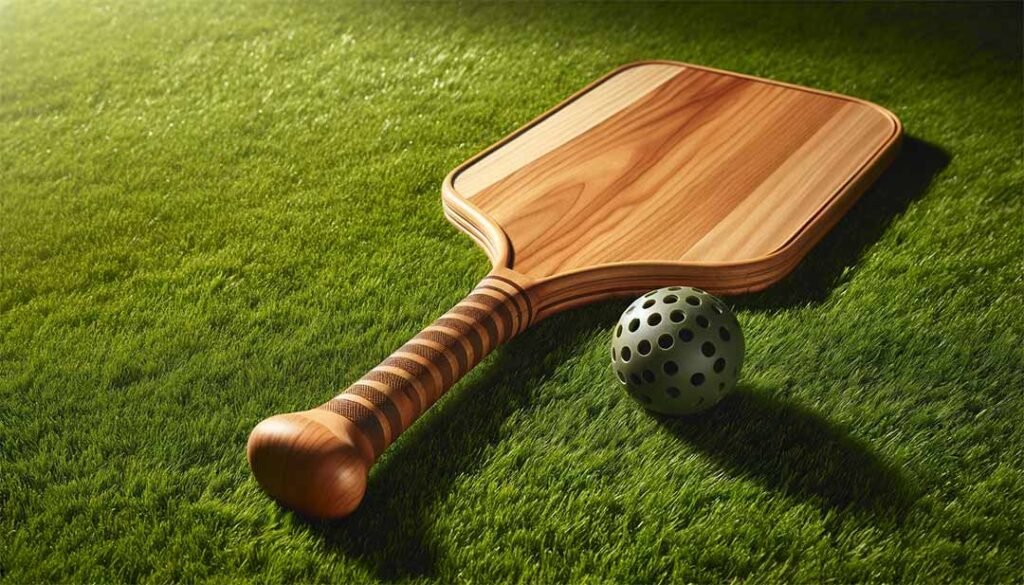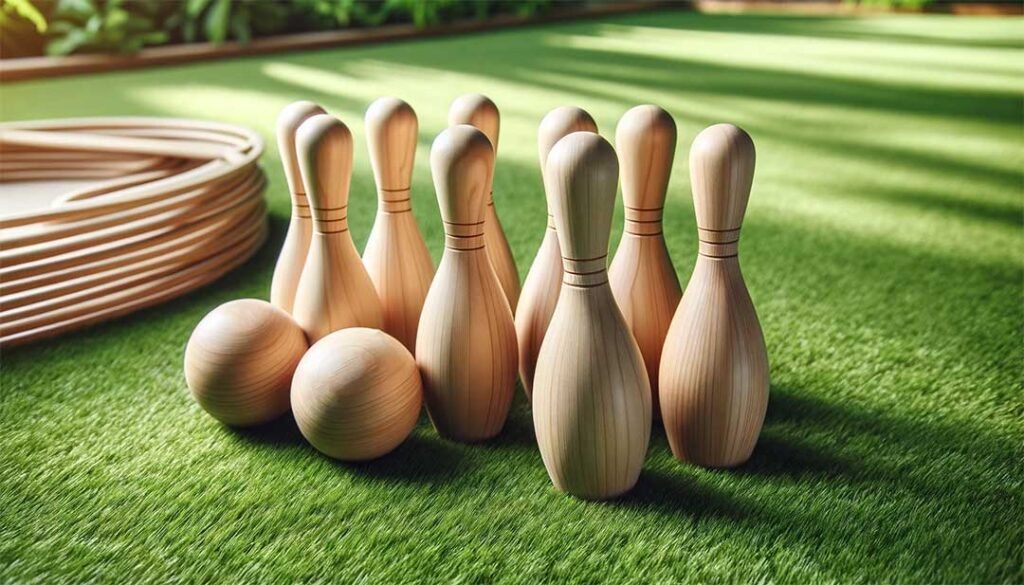Introduction
Pickleball, a fusion of tennis, badminton, and ping-pong, has rapidly evolved from a family pastime into a global phenomenon. This guide introduces you to the world of Pickleball, highlighting its easy-to-learn yet skill-rich gameplay that appeals to all ages.
A Brief Introduction to Pickleball
Originating in the 1960s in the USA, Pickleball is played on a court with paddles and a perforated plastic ball, offering a perfect mix of strategy and accessibility.
Its Growing Popularity Worldwide
The sport’s universal appeal has led to a surge in global popularity, with millions playing in the US and a growing presence worldwide. Ideal for players of all skill levels, Pickleball is not just a sport but a burgeoning community.

Understanding Pickleball Equipment
A. The Pickleball Paddle:
Varieties of Paddles:
- Composite: These paddles, made of composite materials like fiberglass or polymer, offer a blend of power and control.
- Graphite: Lightweight and responsive, graphite paddles suit players seeking enhanced maneuverability.
- Wooden: Traditional wooden paddles provide excellent touch and control, ideal for beginners.
Paddle Selection Guide:
- Play Style Consideration: Determine your play style – whether you prefer power shots, precision, or a balanced approach.
- Grip Size and Shape: Choose a paddle with a comfortable grip size and shape to prevent fatigue during extended play sessions.
B. The Ball:
Indoor vs. Outdoor Balls:
- Material Differences: Indoor balls are designed for controlled indoor play, usually made of softer plastic. Outdoor balls are more durable, constructed with harder materials to withstand outdoor elements.
- Bounce and Flight Characteristics: Understand how indoor and outdoor balls vary in their bounce and responsiveness on different surfaces.
Pickleball Ball Features:
- Size, Weight, and Hole Pattern: Learn about the official dimensions, weight, and the significance of the ball’s hole pattern, affecting flight trajectory and overall play.
C. The Court:
Court Specifications:
- Dimensions: Dive into the specifics of a Pickleball court’s dimensions (20×44 feet for doubles, 20×22 feet for singles) and the distinctive zones marked for different gameplay aspects.
- Layout Elements: Explore the positioning of the baseline, sidelines, and the seven-foot no-volley zone or “the kitchen.”
The Kitchen Zone Importance:
- Strategic Role: Understand how the kitchen area influences gameplay, encouraging players to tactically approach net shots and volleys while abiding by specific rules to avoid faults.

Rules of the Game
A. The Basics:
Scoring System:
- Pickleball typically uses a rally scoring system, meaning a point can be won regardless of the serving team.
- Matches are often played until one team reaches 11 points, with a winning margin of at least two points.
Serving Rules:
- Players serve diagonally, starting from the right-hand side of the court, to the opponent’s service court.
- Only the serving team can score points, with each player on the serving team having the opportunity to serve before losing the serve.
B. In-Game Rules:
Double Bounce Rule:
- Both teams must allow the ball to bounce once on each side after the serve before volleys (hitting the ball without letting it bounce) are allowed.
No-Volley Zone Rules:
- Players cannot volley the ball (hit it in the air without bouncing) while within the seven-foot no-volley zone adjacent to the net.
- Exceptions exist for balls that bounce into the no-volley zone, allowing players to hit them without violating the rule.
C. Faults and Penalties:
Common Faults in Pickleball:
- Faults can include stepping into the no-volley zone when volleying, not allowing the ball to bounce once on each side, or serving into the wrong service court.
Application of Penalties:
- Penalties are generally awarded when a fault occurs, resulting in the loss of the serve or a point to the opposing team.

Playing Techniques and Strategies
A. Serving Techniques:
Power Serve vs. Soft Serve:
- Players often choose between a power serve (hard and fast) or a soft serve (slower with more control) based on their style and opponent’s weaknesses.
- The power serve aims to put pressure on opponents, while a soft serve focuses on accuracy and placement.
Placement and Strategy:
- Serving strategically, targeting weaker areas of the opponent’s court or exploiting vulnerabilities, is key to gaining an advantage.
- Varying serves (direction, speed, and spin) keeps opponents guessing and off-balance.
B. Offensive and Defensive Play:
Strategies for Singles and Doubles Play:
- Singles play often involves more movement and reliance on personal skill, while doubles play emphasizes teamwork and coordination.
- Doubles teams strategize by covering the court efficiently, communicating effectively, and using each player’s strengths.
Defensive Positioning and Shot Selection:
- Players strategically position themselves to defend the court’s vulnerable areas, such as the baseline or the net.
- Shot selection involves choosing between defensive shots (lobbing or dropping the ball) or offensive shots (smashes or drives) based on the situation.
C. Advanced Techniques:
Spin Shots:
- Skilled players incorporate spin shots, such as topspin or backspin, to add variation and unpredictability to their shots.
- Spin shots can create difficulties for opponents in returning the ball due to changes in trajectory and bounce.
Third Shot Drop:
- The third shot drop is a technique used to softly return the ball over the net, often after the serve, to regain control of the game.
- This shot aims to keep the ball low, land softly in the kitchen (non-volley zone), and prevent opponents from making aggressive returns.

Pickleball for Health and Fitness
Physical and Mental Health Benefits: Pickleball offers a myriad of health benefits. It’s an excellent workout that improves cardiovascular health, agility, and balance. Moreover, it enhances mental acuity and fosters hand-eye coordination.
Pickleball as a Form of Cardio Exercise: The sport involves constant movement, offering a fantastic cardio workout. It combines elements of strength, agility, and endurance, making it an ideal exercise for individuals seeking a fun way to stay active.
The Social Aspect of Pickleball
Building Communities Around the Sport: Pickleball has a remarkable ability to bring people together. It fosters a sense of community, encouraging players of all ages and skill levels to engage, connect, and forge friendships both on and off the court.
Pickleball in Clubs and Recreational Centers: Many clubs and recreational centers offer Pickleball programs. These venues provide an inclusive environment for players to enjoy the sport, offering facilities and organized events for enthusiasts.
Competitive Pickleball
Overview of Tournaments and Leagues: Pickleball has a thriving competitive scene with various tournaments and leagues held worldwide. These events cater to players of different skill levels, offering opportunities for friendly competition or serious competitive play.
How to Get Involved in Competitive Play: For those interested in competitive Pickleball, joining local clubs, seeking information on tournaments, and participating in leagues are excellent starting points. It’s a chance to challenge oneself and experience the thrill of competitive sportsmanship!

FAQs
1. What equipment do I need to play Pickleball?
To play Pickleball, you’ll need a paddle, a Pickleball, and access to a Pickleball court. Shoes suitable for court sports are also recommended.
2. Is Pickleball suitable for all ages?
Yes, Pickleball is a versatile sport suitable for players of all ages. It’s adaptable to various skill levels and physical capabilities.
3. Can I play Pickleball indoors and outdoors?
Yes, Pickleball can be played both indoors and outdoors. There are slight differences in the equipment used for each setting.
4. How can I improve my Pickleball skills?
Practice regularly, work on your serving technique, positioning, and strategies. Consider taking lessons or joining a club to enhance your skills.
5. Is Pickleball a physically demanding sport?
Pickleball offers a good balance of exercise and fun. While it’s not as physically demanding as some sports, it still provides a good workout, especially for cardio and agility.










